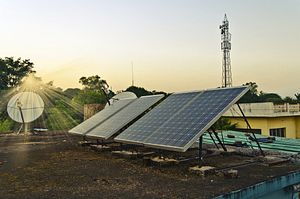At the direction of Prime Minister Narendra Modi, India has decided to take the next leap forward in its quest to achieve a low-carbon economy and energy security, inviting huge investments in renewable energy, particularly solar energy. By investing heavily in solar, wind, biomass, energy efficiency, and conservation (and even nuclear, which is considered “clean” by the establishment), the government aims to build energy self-sufficiency and self-reliance. However, the road ahead is not easy. The biggest stumbling block that could come in the way of India’s effort to become a leader in the solar energy market is land acquisition.
India “plans to quadruple its renewable power capacity to 175 GW by 2022,” according to the budget speech delivered by Finance Minister Arun Jaitley. Of this, 100 GW is to consist of solar energy. The government has sought more than $100 billion in investment to achieve this solar energy target and ensure that the contribution of solar power to the country’s energy portfolio is raised to 10 percent. Modi and his ministers have gone into overdrive to secure international financial assistance and investment. India has already received assurances in this regard from Japan, Germany, France, and the U.S., among others.
When the target of 100 GW was announced by the Modi government in 2014, it was greeted with immense skepticism, given that it would mean India would have to produce more than 30 times the country’s current installed capacity. The government announced plans to build 25 solar parks and several major solar power projects in Rajasthan, Madhya Pradesh, Gujarat, and Jammu and Kashmir. Record low tariffs and booming investments (owing to subsidies, tax breaks, and even consideration of a dollar-denominated tariff mechanism for solar power at grid parity) have raised optimism among investors as well as the industry. In fact, the world’s largest solar power plant (750 MW) is expected to be completed in the Rewa district of Madhya Pradesh by 2017 and, surprisingly, the cost of electricity production is estimated to be as low as 5.50 rupees ($0.086) per unit of power – just a tad higher than the cost of thermal power generation.
Land Availability
For these goals to come true by the stipulated year and for foreign investors to continue to enter the Indian solar power market, the issue of land availability needs to be addressed urgently. It is being estimated that all of the proposed solar projects would require up to 500,000 acres. Unfortunately, the government is battling to get the Land Acquisition Bill passed by parliament. The CEO of Japan’s SoftBank, which announced a joint venture with India’s Bharti Enterprises and Taiwan’s Foxconn Technology Group, even hinted that if the Indian government could make land available, it might consider manufacturing the solar panels in India instead of importing them. This would give a substantial boost to the Modi government’s “Make in India” initiative.
The current law on land acquisition is considered to be highly investment-unfriendly, given provisions that mandate social impact assessment while requiring consent from 70 percent of the farmers in the case of public-private partnership projects and 80 percent, when the land is acquired for private companies. The process itself can take up to three years, during which the cost of project implementation is likely to rise. Because of the stalemate on the bill, several state governments are also being held back from steering their solar power policies forward, causing delays and cost overruns. Interestingly, the government is now considering submitting to the opposition’s demands and reinstating the consent clause in the bill, but in a watered form perhaps. It remains to be seen how the amended bill will possibly affect the process of land acquisition.
The tussle between agricultural communities and industrial entities over resources (land and water) is an age-old one in India. With large tracts of land earmarked for agriculture and with a sharp decline in cultivable land area, the government will find it increasingly challenging to acquire land to develop the proposed solar parks and projects.
It is also worth remembering that even if plenty of unused, infertile land is available, if it is not close to the urban areas where demand for electricity is greatest and/or to power transmission grids, it is not viable, given the cost of connecting to the power grids (building transmission lines) and the greater transmission losses.
To reduce the pressure on land, the government has decided to invest in off-grid rooftops and generate at least 40 percent of planned capacity from them. Recently, it began talks with the World Bank and the Asian Development Bank to secure $2 billion in funding to provide subvention to banks that could provide cheap loans for rooftop solar projects, mainly for houses and offices.
Yet another initiative is the canal-top and canal-bank solar power projects. India is the first country to build such a plant – 10 MW plant built over a 3.6-kilometer stretch of the Sardar Sarovar Canal System in Gujarat. This model is now being emulated by other Indian states such as Haryana and Odisha. One advantage of this model is that it also saves water by reducing water evaporation from the channels underneath. Decentralization would seem to be a reasonable solution or alternative for land acquisition, but it will not be enough to achieve the assigned target by 2022.
Ahead of the Paris Climate Summit, India is trying to push the clean energy agenda, instead of focusing solely on emissions reduction. It intends to use its rapid strides in solar energy (an increase in solar capacity from 2.5 MW to 1,759 MW since 2012) as its biggest bargaining chip at the Paris Summit. However, the government must find ways to overcome the “land” conundrum if members of the international community are to take these ambitious goals seriously and if it is to attract solar power investment.
Dhanasree Jayaram is a Project Associate, Manipal Advanced Research Group (MARG), Manipal University, Karnataka, India and Research Fellow, Earth System Governance Project.

































